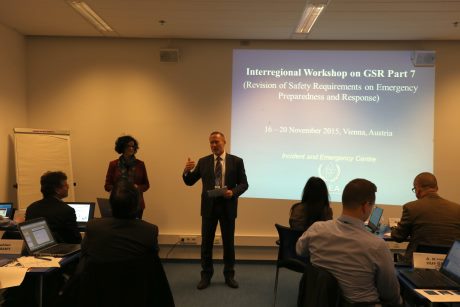New safety requirements on nuclear emergency preparedness and response published by the International Atomic Energy Agency (IAEA) incorporate lessons learned and developments since 2002, including lessons from Fukushima.
 |
| Jean-Francois Lafortune addresses the workshop on GSR 7 (Image: JC Castillo/IAEA) |
Preparedness and Response for a Nuclear or Radiological Emergency is part 7 of the IAEA's General Safety Requirements series (GSR 7). The standards reflect an international consensus on what constitutes a high level of safety for protecting people and the environment from harmful effects of ionizing radiation, and are applicable throughout the entire lifetime of all facilities and activities. They are sponsored by 13 international intergovernmental organizations, including the OECD Nuclear Energy Agency, the United Nations Environment Program, the World Health Organization and the World Meteorological Organization as well as the IAEA itself.
The new standards take into account lessons and developments in the area of emergency preparedness and response (EPR) since the last edition was published in 2002, including lessons learned from the Fukushima Daiichi accident of March 2011. They also take into consideration the recommendations of the International Commission on Radiological Protection (ICRP).
The publication establishes strengthened requirements for aspects of EPR including emergency management systems, protection strategies for a nuclear or radiological emergency, resilience of emergency arrangements against a range of hazardous conditions, the protection of emergency workers, and cooperation in the case of a transboundary emergency.
EPR is a national responsibility, but the IAEA provides support through its programs for member states to set up national EPR frameworks that are compatible with international standards. The safety requirements are intended for use by governments, emergency response organizations and other authorities at the local, regional and national levels, operating organizations, regulatory bodies and relevant international organizations. "This publication is designed to guide states in developing and reinforcing integrated systems when faced with emergency situations and how they can go about achieving it with our assistance," Jean-Francois Lafortune, emergency preparedness coordinator at the IAEA Incident and Emergency Centre, said.
Speakers at an IAEA workshop on the new safety requirements last week underlined the need for emergency response frameworks to be linked nationally, regionally and internationally. "Countries need to talk to their neighbours to ensure that response systems are harmonized and well-coordinated," Vincent McClelland, director of international emergency management and cooperation at the US Department of Energy's National Nuclear Security Administration, said.
A series of similar workshops will be held over the next two years at which IAEA member states will be able to learn about the new requirements and how to apply them in practice.
Researched and written
by World Nuclear News




_18570.jpg)
_16159.jpg)
_49205.jpg)
_18938.jpg)





